Content
In spring and early summer, sorrel soup appears on the table. Many call it green cabbage soup. This delicious seasonal dish replenishes the body with vitamins, organic acids (malic, oxalic, citric) and minerals. Later, in hot summer, sorrel will acquire a number of qualities that are harmful to the body. It increases the concentration of oxalic acid. And this is fraught with sad consequences: the occurrence of sand or kidney stones, gout, and so on. The correct name for the perennial sorrel we grow in our gardens is sour sorrel, or ordinary (Rumex acetosa). It belongs to the Buckwheat family.
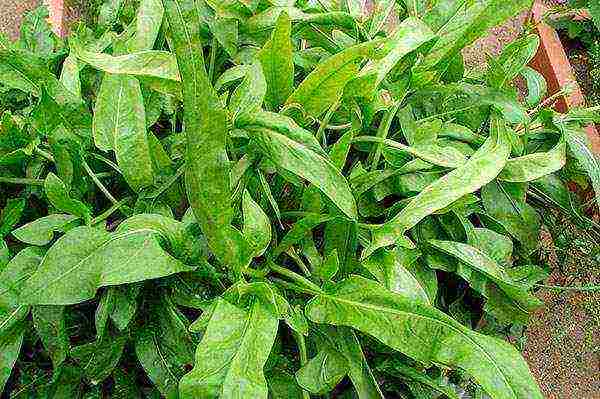
Sorrel in the garden
Highly productive varieties of sorrel have been developed, the seeds of which are sold in stores. They differ not only in the size and shape of the leaves, but also in some other features: taste, degree of resistance to flowering, winter hardiness, productivity, etc. There are even ornamental varieties of sorrel that can be used as a flower garden decoration and as edible greenery. It is recommended to renew sorrel crops every 3-4 years, later they degenerate. Growing scheme: 20 x 5 - 8 cm.
Variety "Belleville". This old variety is not inferior in quality to new products. Greens are rich in vitamin C, carotene and trace elements. The variety is frost-resistant. Leaves with thick petioles, they appear in early spring. During the season, it is possible to collect up to 7 kg per square meter. The purpose of sorrel is universal, i.e. its greens are used fresh, boiled and canned.
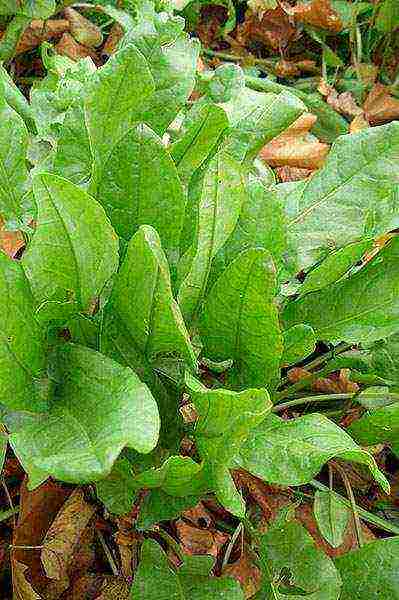
Sorrel
Variety "Emerald Snow". The valuable quality of this variety is its yield. From germination to collection of leaves, 46 - 52 days pass. The leaves are rich in vitamins (C, B group, carotene), organic acids. Seeds can be sown not only in spring and before winter, but even in summer. A raised, spreading rosette of ovoid, slightly bubbly leaves looks beautiful in the garden. The variety does not shoot for a long time. Productivity up to 7.5 kg per square meter. The leaves have such a pleasant taste that they are added to green salads and made into soup. The leaves are salted, canned and frozen for the winter.
Variety "Malachite". This winter-hardy early-ripening variety amazes with the growth rate of beautiful green leaves with wavy edges. It takes only 40 - 45 days from germination to leaf cutting! Leaves, 12-15 cm long, are collected in an erect loose rosette. Their surface is smooth or slightly bubbly.
Variety "Odessa broadleaf". The winter-hardy early-ripening variety gives a full harvest of leaves within 45 days after germination. Dark green elongated ovate leaves (up to 16 cm long, 7 cm wide) are collected in a loose erect rosette. Productivity (3 - 8 kg) depends on growing conditions to a greater extent than that of other varieties. The leaves are suitable for salads, soups and winter preparation. They contain a lot of vitamins, iron and potassium.
Variety "Shirokolistny". The variety is becoming popular and is often preferred over other varieties. It gives a harvest of greenery already 40 - 45 days after germination. Elongated ovate leaves are kept on a long petiole. Productivity up to 8 kg per square meter. The taste of the leaves is slightly acidic, so sorrel is good for salads. It is a winter hardy variety. In hot, dry summers, it is strongly arrowed. Can be grown in one place for 4 - 5 years. The last cut is carried out in mid-August. This period gives a margin of time for the bushes to be able to prepare for winter.
Variety "Large-leaved". This is one of the earliest varieties (30 - 45 days from germination to mass harvest).I like it more than the others because of the pleasant taste of the light green leaves. High frost resistance. The cultivar is considered to be relatively resistant to stem stemming.
Varieties "Maykop 10" and "Spinach" early maturing, their feature is a low acid content. Hardy enough.
Variety "Altai". It has spear-shaped leaves on thin long petioles. At first, young leaves are dark green, then they have a reddish tint. The taste of greens is moderately acidic and sour (according to various estimates). High frost resistance.
Lyons variety. This is a rather vulnerable variety in our climate, which can freeze out or dry out in unfavorable winters. It is a pity, since this is really the kind that can be praised for the high quality and excellent taste of the greens. Fleshy leaves and thick stalks grow quickly, so cutting is done several times per season.
Variety "Bloody Mary" refers to decorative. This is a novelty worth taking a closer look at. The leaves are decorated with a pattern of burgundy veins. You can collect leaves (length up to 15 cm, width up to 10 cm) from a beautiful bush 45-50 days after germination. Cutting is done several times during the season. The variety is winter-hardy. Spectacular leaves are admired not only in the flower garden, but also in ... salad. A delicious soup is prepared with them, they are salted.
Variety "Red veins". Another decorative variety of common sorrel. A bush about 40 cm high is decorated with spear-shaped green leaves with burgundy-red veins. The leaves are collected in an upright compact rosette. Flowers are small, collected in inflorescences. Actively growing sorrel is recommended to be planted among stones or in mixborders. Better on nutritious soil with regular moisture. The brightest pattern appears on the leaves of those bushes that grow in a sunny place or with a little shade. They acquire a less expressive color in the shade. Seeds can germinate for a long time (up to 3 weeks), so it is recommended to grow the variety through seedlings. It is planted in a permanent place with an interval of 30 - 40 cm. Only young leaves are used for food, until they become callous.

Sorrel in the meadow
Sorrel already in early spring pleases us with a harvest of vitamin greens. This culture is not afraid of low temperatures and is very unpretentious.
Sorrel varieties by ripening time
Sorrel varieties
Early sorrel yields greens 40-45 days after pecking the leaves. This category includes varieties:
• Spinach
• Broadleaf
• Sanguine
• Emerald Snow
• Belleville
• Malachite
• Emerald King
Description of the variety Sanguine
Sorrel variety Sanguine
The harvest of leaves will have to wait only 40-45 days. Plant height is 30 cm. Smooth, large, green leaves have reddish veins. The stem is colored red-yellow. The leaves have a pleasant, slightly acidic taste.
Average ripening times are inherent in varieties:
• Maikop 10
• Champion
• Bloody Mary
Description of the Champion variety
Sorrel variety Champion
The erect rosette of the plant reaches a diameter of 30 cm. The height of the aboveground part is about 40 cm. The shape of green leaves is elongated-oval, the petioles are of medium height. The edges of smooth large leaves are slightly wavy. Taste characteristics are good (juicy leaves have a moderately sour taste). The yield is very high.
Sorrel varieties for central Russia
Early, mid-early and mid-season plants can be grown in central Russia. It is especially worth highlighting such varieties as:
• Green fairy tale
• Maikop 10
• Abundant
• Spinach
• Broadleaf
• Sanguine
• Emerald Snow
• Belleville
• Champion
• Emerald King
• Malachite
• Lyons
• Bloody Mary
• Red veins
Description of the Belleville variety
Sorrel variety Belleville
Plants give an early harvest of greenery. The leaves are oval-elongated. They are painted light green. The variety is resistant to flowering. The yield is very high.
Decorative varieties of sorrel
Some sorrel varieties not only produce edible leaves, but also look very impressive on the beds. The most popular are plants with reddish veins:
Sorrel variety Bloody Mary
• Bloody Mary (medium-sized green leaves are decorated with burgundy veins, the variety is highly winter-hardy).
• Red veins (spear-shaped green leaves have burgundy-red veins, which are brighter, the more sunny place is chosen for growing the plant).
The best sorrel varieties for Siberia
Sorrel can withstand low temperatures - seeds germinate already at 2-3 degrees Celsius. Leaves begin to grow actively at 15-16 degrees. The following varieties are grown in Siberia:
• Belleville
• Maisky
• Maikop 15
• Altai
Description of the Altai variety
Plants of this variety have spear-shaped leaves. Their color changes as they grow - the dark green leaves acquire a reddish tint. The variety is characterized by high frost resistance. The taste of the leaves, depending on the growing conditions, can be either slightly acidic or sour.
Sorrel varieties differ in both external characteristics and taste. Plants are unpretentious and productive - early greens can delight you for three or four seasons (older plantings should be renewed, as the plants gradually weaken).
Sorrel is one of the most common and beloved varieties of aromatic herbs. The information provided will help you choose the right sorrel variety and get a rich and healthy harvest. We invite you to get acquainted with the most common varieties of this crop and with the agrotechnical requirements for soil, cultivation, care and collection of sorrel seeds.
The best varieties
The most well-proven varieties include:
back to contents ↑ Altai
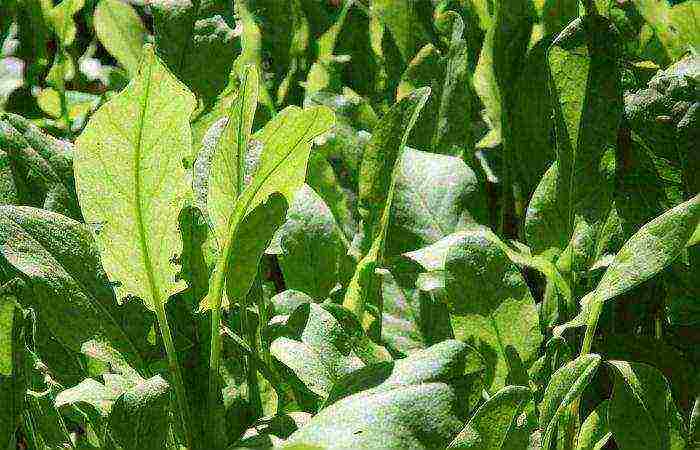
The leaves of this variety are large, smooth, spear-shaped, dark green saturated shade. Petioles of leaves are thin, long. The variety tolerates frost and drought well. Not picky about the soil. It rarely succumbs to various diseases and pest attacks. The taste of the leaves is pleasantly sour. Leaves and petioles do not separate into coarse fibers during grinding.
back to contents ↑ Belleville
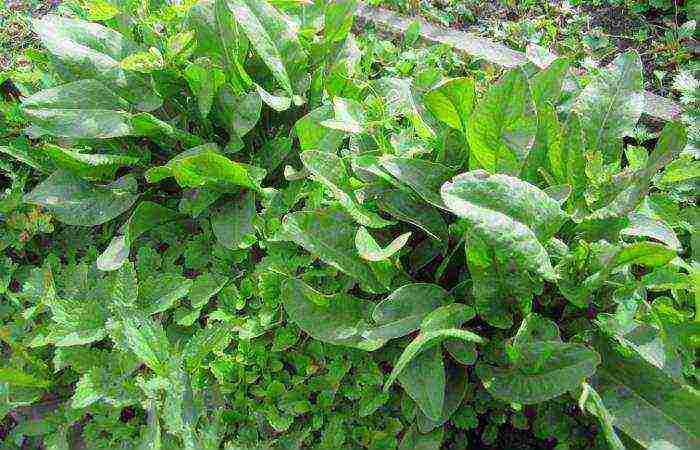
The leaves are large, ovoid, bright green in color. Leaf petioles are of medium thickness, low. The variety tolerates frost well. Requires constant watering. The variety is very easy to infest with powdery mildew and rust. The taste of the leaves is moderately acidic, slightly spicy. The petioles are divided into non-coarse fibers during grinding.
back to contents ↑ Large-leaved
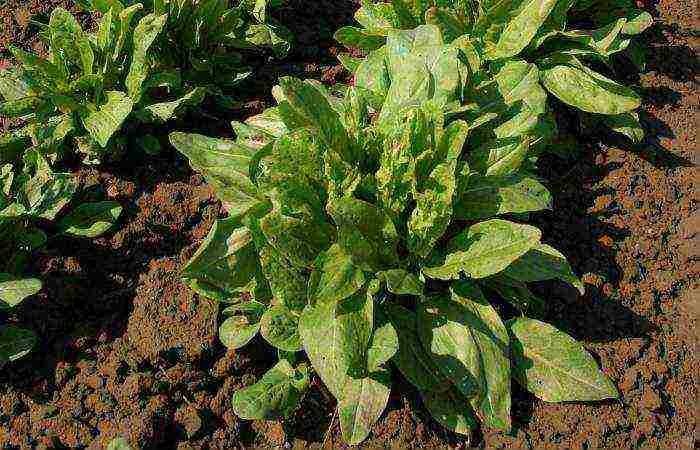
The leaves of this sorrel variety are large, smooth, oval-ovoid, light green in color. The leaf petioles are thick and tall. The variety is of high quality, well stored, suitable for pickling and freezing. Large-leaved sorrel tolerates severe frosts well. Resistant to disease infestation and pest attacks. The taste of the leaves is pleasantly sour. The petioles do not divide into fibers during grinding.
Back to contents ↑ Lyons

The leaves of this sorrel variety are spear-shaped, rich in light green color. Petioles of leaves are of medium thickness, low. The Lyon variety is high-yielding. Poorly tolerates drought and frost. The variety is very easy to get infected with diseases. The taste of the leaves is soft, slightly acidic. The petioles are not divided into coarse fibers during grinding.
back to contents ↑ Malachite

The leaves of this sorrel variety are large, wide, ovoid, and dark green in color. The petioles are dense, long. The variety is not picky about the soil, tolerates high frosts and drought well. It rarely becomes infected with various diseases and succumbs to pest attacks. The taste of the leaves is soft, slightly acidic. The petioles are divided into non-coarse fibers during grinding.
back to contents ↑ Ordinary
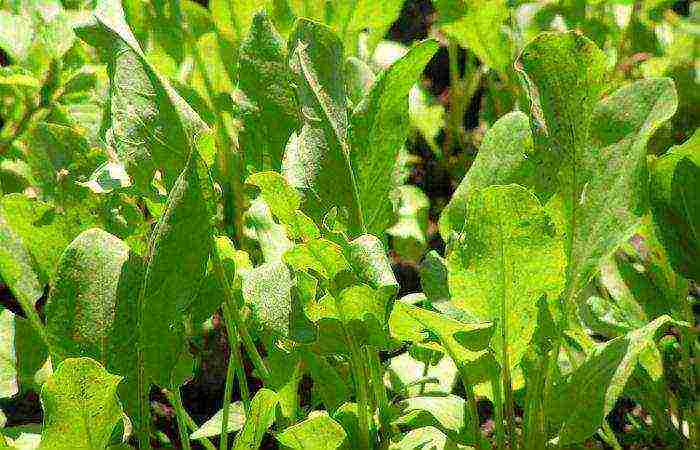
The most common and favorite sorrel variety among summer residents and gardeners. The leaves of this sorrel variety are long, spear-shaped, dark saturated green.The leaf petioles are thin and tall. The variety is resistant to cold and drought. It rarely succumbs to various diseases and pest attacks. The variety is considered the highest yielding variety. The taste of the leaves is pronounced sour, slightly spicy. Petioles are not divided into fibers during grinding.
back to contents ↑ Broadleaf
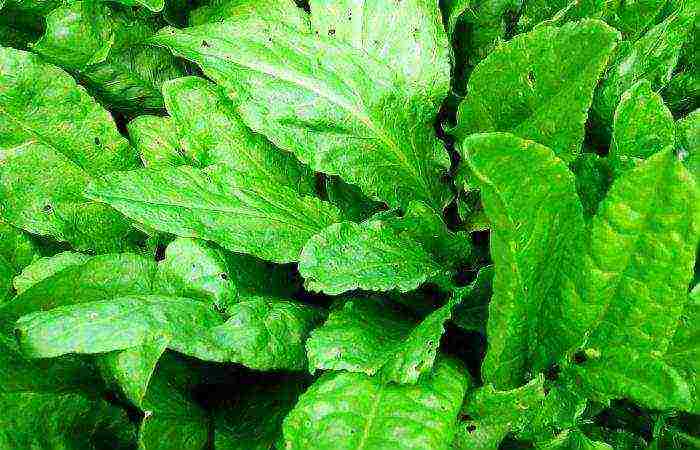
The leaves of this sorrel variety are large and wide, ovoid, bright green in color. The leaf web is very thin. Petioles are of medium thickness, not high. The variety is high-yielding and drought-resistant. Does not tolerate severe frosts very well. It is easily attacked by pests and various diseases. The taste of the leaves is moderately acidic, slightly spicy. The petioles are divided into non-coarse fibers during grinding.
back to contents ↑ Spinach
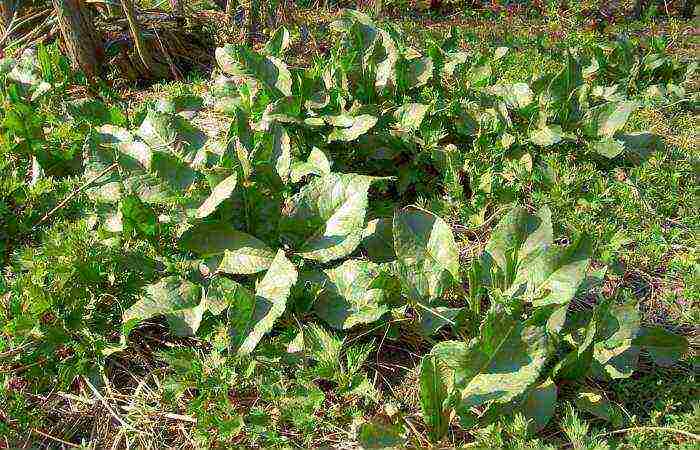
The leaves of this sorrel variety are large, ovoid, dark green in color. Petioles are small, thin. The variety is high-yielding, frost-resistant. Poor drought tolerance. It easily lends itself to pest attacks and infection with various diseases. The taste of the leaves is moderately sour. Oxalic acid is practically not present in the leaves. The taste of the leaves is given by malic and citric acid. Petioles are not divided into fibers during grinding.
to the content ↑ Site requirements
To obtain a good and healthy sorrel harvest, it is necessary to allocate a fertile and constantly moistened soil area for sowing. The site should be as clear of weeds as possible. Cleansing the site and dressing it should be done in early autumn, and sowing only in mid-spring. The soil should be well fertilized with humus. Slightly acidic and alkali-free soils are best suited for planting sorrel. Before sowing in the spring, you need to dig up the soil well and apply nitrogen fertilizers. The depth of groundwater on the soil selected for planting sorrel should not exceed 1 m2. You should also not sow sorrel in the same place for more than 4 years.
back to contents ↑ Seed preparation and sowing
Sorrel seeds do not require special preparation before sowing. They can be sown dry or pre-soaked for 1-2 hours. Sorrel should be sown in soil slightly irrigated with water to a depth of 2 to 3 cm.The distance between the rows of sorrel should be at least 25 cm.After sowing the seeds in a row, they should be covered with dry soil and compacted (this can be done with the foot or the back of the rake ). The first shoots appear approximately two weeks after sowing.
back to contents ↑ Seasonal care
Sorrel care comes down to constant weeding and loosening of the soil, abundant watering and the fight against pest diseases. Also, if necessary, it is necessary to feed the plant with biological fertilizers. It is best to mulch the soil with needles after each periodic cut of sorrel leaves and feed the plant with nitrogen fertilizer mixtures.
back to content ↑ Harvesting
The first harvests can be carried out when 6-7 leaves of sufficient size appear on the bushes. When cutting the leaves, you need to leave the leg up to 4 cm from the soil so as not to damage the integrity of the bush and get the next harvest. You need to start collecting sorrel in May, and you can finish it in the fall. It all depends on the seeding time and the rate of crop growth. You can store the crop fresh frozen or salted.
back to contents ↑ Selection of new seeds
High-quality sorrel seeds can be obtained only in the second year after sowing sorrel in open ground. Seeds are best harvested from early summer sowing plants. It is best to leave strong, uncontaminated and undamaged plants on the testes. The sorrel throws out a tall arrow on a thick stalk, on which the seeds form. You need to harvest the seeds by cutting off the entire seed stem. It is best to dry the seeds on the already cut arrows, since when the seeds are fully ripe in the garden, they are likely to self-sow.
Sorrel is a perennial herb growing in height from 30 to 100 cm.Young leaves that appear in spring are able to withstand low temperatures. It grows in one place for 3-4 years, blooms a year after planting. Sorrel seed germination temperature +2, +3, shading tolerates.
Young sorrel leaves are eaten. Sorrel is quite rich in vitamins - these are C, A, vitamins of group B (B1, B2), PP, there is protein and sugar. And also - citric acid, malic acid, oxalic acid, mineral salts of potassium and iron. Sorrel greens are good for the human digestive system, especially raw.
In cooking, sorrel is used for cooking first courses (cabbage soup, borscht, soups), as a filling for pies.
On a note
Before flowering in sorrel, in its old leaves and petioles, oxalic acid accumulates, which is not desirable for humans, at this time it is not recommended to eat sorrel.
Varieties

Sorrel variety Belleville - the best, early, productive variety, leaves are tender, slightly acidic, with a pleasant taste,
Spinach - leaves are large, slightly acidic in taste, with a high content of vitamin C, grow back early.
Odessa broadleaf - an early ripe sorrel variety, the harvest is obtained in 45 days. The leaf is dark green, winter-hardy and drought-resistant.
Growing
Sorrel is sown in early spring on beds with a height of 12 cm. Under the sorrel, half a bucket of humus per 1 sq. tablespoons of nitrophoska, 1 teaspoon of urea and a half-liter jar of fluff lime. Sorrel grows well on peat bogs.
Sorrel is grown by dividing the root and sowing seeds into the soil.
Large seeds are taken for sowing, they are pre-soaked in water, the crops are covered with a film to accelerate germination and emergence of seedlings.
In summer in June and July, you can sow sorrel seeds again. Seeds must be sown in moist soil to a depth of 2-3 cm, and in dry soil - 3-4 cm.
In the second year, in the spring, the plants are transplanted to a permanent place or thinned out, placing them 5 centimeters apart.
Peduncles are mainly removed, and left on one plant only to obtain seeds.
Sorrel greens - leaves and stalks, are removed for food at 10 cm throughout the season until peduncles appear.
Old sorrel plantings are constantly renewed, in this case, the harvest of early greens is ensured. Plastic wrap covering the sorrel in early spring will give the first harvest 15 days earlier than usual.
To get your own seeds, you need to sparse sorrel bushes, and do not cut the leaves. In June-July, the seeds ripen and fall off. The stems are cut off, placed under a canopy, where the sorrel seeds ripen. Then they are threshed, cleaned of impurities.
Growing sorrel in a greenhouse
In order to grow sorrel in a greenhouse, it is best to use biennial plants. They are dug out, trying not to damage the bud, cut off the leaves and put in boxes with plastic wrap. The roots are kept at a temperature of 0-1.
In the spring, they are planted in a greenhouse in rows according to the scheme of 10-15 cm. 6-8 kg of roots are consumed per square meter. Growing temperature 10-12, soil moisture 80%.
Sorrel does not tolerate drying. With insufficient watering, it forms a shallow rosette and a flower arrow. This reduces the quality of the crop. From a square meter, you can cut up to 1.5 kg of green leaves at a time.
When cultivating sorrel, it is necessary to ventilate the room daily. Plants are ready for harvest in a month. Then they are cut again after 3-4 weeks.
You can store the greens of sorrel leaves in the refrigerator for 2-3 weeks, at a temperature of 0- + 1 in plastic bags. At room temperature - 2-3 days.


